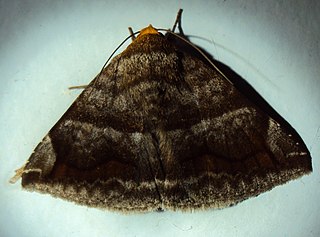
Buzara onelia is a moth of the family Erebidae. It is found from the Indian subregion to Sri Lanka, Myanmar, Sundaland, the Philippines and Japan.

Buzara umbrosa is a moth of the family Erebidae. It is found in China, India and Sri Lanka.

Ischyja manlia is a species of moth of the family Noctuidae first described by Pieter Cramer in 1776. It is found in the Indian subregion, Sri Lanka, Myanmar, Thailand, China, Okinawa, Sundaland, Sulawesi, Korea, the southern Moluccas, Australia (Queensland) and Palau. Adults pierce the skin of fruit to suck the juice.
Apatelodes quadrata is a moth in the family Apatelodidae first described by E. Dukinfield Jones in 1908. It is found in Paraná, Brazil.
Lipocosma grimbaldalis is a moth in the family Crambidae described by William Schaus in 1924. It is found in Guatemala.
Phaedropsis domingalis is a species of moth in the family Crambidae. It was described by William Schaus in 1920. It is found in the Dominican Republic.
Phaedropsis maritzalis is a species of moth in the family Crambidae. It was described by William Schaus in 1920. It has been found in Guatemala, Honduras and Venezuela.
Phostria cleodalis is a moth in the family Crambidae. It was described by William Schaus in 1920. It is found in Bolivia.
Piletocera agathanalis is a moth in the family Crambidae. It was described by William Schaus in 1924. It is found in Panama.
Pilocrocis dentilinealis is a moth in the family Crambidae. It was described by William Schaus in 1920. It is found in Rio de Janeiro, Brazil.
Polygrammodes herminealis is a moth in the family Crambidae. It was described by Schaus in 1920. It is found in Brazil (Paraná).
Polygrammodes supremalis is a moth in the family Crambidae. It was described by William Schaus in 1920. It is found in Paraná, Brazil.
Praeacrospila patricialis is a moth in the family Crambidae. It was described by William Schaus in 1912. It is found in Costa Rica.
Stenorista fortunata is a moth in the family Crambidae. It was described by Schaus in 1912. It is found in Costa Rica.
Syllepte birdalis is a moth in the family Crambidae. It was described by William Schaus in 1920. It is found in Venezuela.
Syllepte anchuralis is a moth in the family Crambidae. It was described by William Schaus in 1920. It is found in Guatemala.
Syllepte nebulalis is a moth in the family Crambidae. It was described by William Schaus in 1920. It is found in Peru.
Syntrita nimalis is a moth in the family Crambidae. It was described by William Schaus in 1924. It is found in Bolivia.
Ulopeza sterictodes is a species of moth in the family Crambidae. It was described by George Hampson in 1912. It is found in Papua New Guinea.

Sphingomorpha chlorea, the sundowner moth, is a species of moth in the family Erebidae that is native to Africa and southern Asia. The species was first described by Pieter Cramer in 1777. It is a fruit-piercing moth and a notorious pest in orchards. The fruit is pierced while performing a vertical and rhythmic movement of the head.



